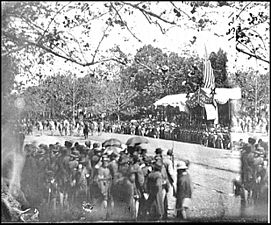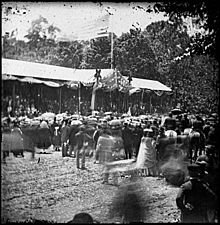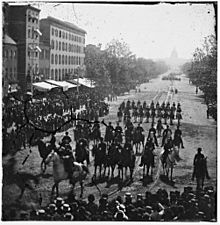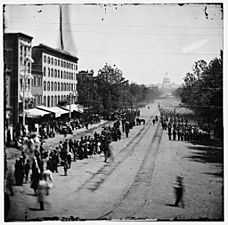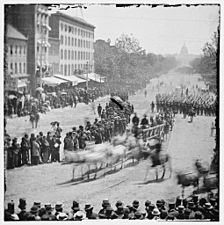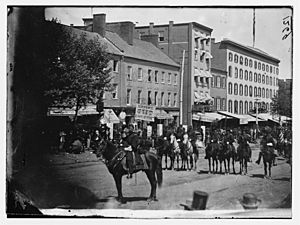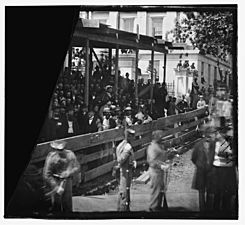Grand Review of the Armies facts for kids
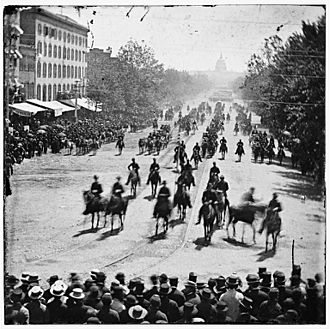
Grand Review of the Armies on Pennsylvania Avenue, in the national capital city of Washington, D.C., heading northwest from the United States Capitol (dome visible in rear) towards the White House (Executive Mansion) at 15th Street, N.W., by the United States Treasury Department building, at the conclusion of the American Civil War (1861–1865), May 23–24, 1865.
|
|
| Date | May 23–24, 1865 |
|---|---|
| Location | Pennsylvania Avenue, Northwest, Washington, D.C. |
| Participants |
|
The Grand Review of the Armies was a huge military parade. It happened in Washington, D.C. on May 23–24, 1865. This event celebrated the Union's victory in the American Civil War (1861–1865). Soldiers from the Union Army marched through the capital city. They were cheered by large crowds and important leaders. These leaders included President Andrew Johnson. The parade took place about a month after Abraham Lincoln was assassinated.
Contents
Why the Grand Review Happened
On May 10, 1865, President Andrew Johnson announced that the Civil War was almost over. He planned a big parade to honor the soldiers. One goal was to lift the spirits of the capital city. Washington, D.C. was still sad after President Lincoln's death.
Three main Union armies were close enough to join the parade.
- The Army of the Tennessee arrived by train.
- The Army of Georgia, led by William Tecumseh Sherman, came from North Carolina. This army had just won battles in the Carolinas. They also accepted the surrender of a large Confederate army.
- The Army of the Potomac arrived on May 12. This army had won important battles in Virginia.
Soldiers from different armies met up again. Sometimes, soldiers from different armies would argue about which army was better. General Sherman wanted his Western soldiers to look their best. He made sure their uniforms were clean and shiny.
The First Day: Meade's Army Marches
On May 23, 1865, a sunny day, the parade began at 9:00 a.m. A signal gun fired one shot. Maj. Gen. George Meade led his troops. Meade was the hero of the Battle of Gettysburg. About 80,000 men from the Army of the Potomac marched. They paraded down Pennsylvania Avenue. Thousands of people watched them.
The soldiers marched 12 men across the road. Artillery (cannons) followed them. Then came cavalry (soldiers on horseback). The cavalry line stretched for seven miles. Everyone was happy and celebrating. Crowds and soldiers often sang patriotic songs. The parade moved towards the reviewing stand. This stand was in front of the White House.
President Andrew Johnson, General Ulysses S. Grant, and other leaders waited there. When Meade reached the stand, he got off his horse. He joined the leaders to salute his men. His army marched past for over six hours.
The Second Day: Sherman's Army Marches
The next day, May 24, at 10:00 a.m., General Sherman led his armies. About 65,000 men from the Army of the Tennessee and the Army of Georgia marched. They showed great military precision. Many people had never seen Sherman before. For six hours, under bright sunshine, his men paraded. These were the soldiers who had marched through Georgia. They had also defeated an army in Tennessee.
Joyful crowds lined the sidewalks. People looked from windows and rooftops. They wanted to see this Western army. Unlike Meade's army, Sherman's force had many people following them. These were freed slaves, workers, and others who had come from Savannah. At the very end of the parade, there was a large herd of cattle. These animals had been taken from farms in the Carolinas.
What Happened Next?
Within a week after the parades, the two armies were broken up. Many volunteer soldiers were sent home. They were officially released from the army.
Even though there were still small conflicts in the South, the main fighting ended. The soldiers going home showed everyone that the Civil War was truly over. People could start returning to normal life.
Today, the National Memorial Day Parade marches along parts of this historic route. This parade is held by the American Veterans Center. It reminds us of the Grand Review and the end of the Civil War.
Images for kids



